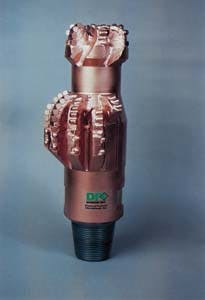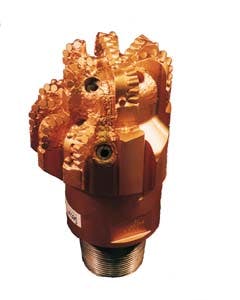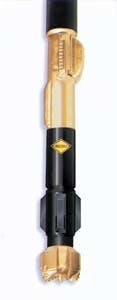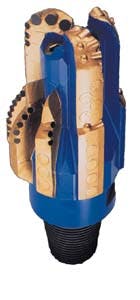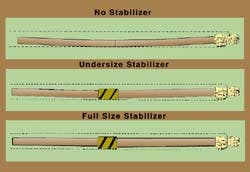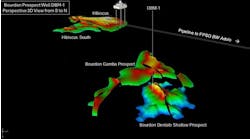DRILLING OPERATIONS Reaming-while-drilling keys effort to reduce tripping of long drillstrings
Fewer casing strings, larger gauge TD, ready-to-case
holes sought with re-developed technology
Leonard Le Blanc
Editor
DPI's recently introduced SpeedReamer bi-center drill bit has increased penetration rates by 29% over conventional bi-center bits.
The increasing number of deep boreholes and deepwater wells is focusing attention on the costs, time, and risks associated with tripping long drillstrings. In many deep wells, tripping time exceeds drill bit life.
Four events appear to drive the process of drillstring tripping: bit changeout, reaming trips, directional re-orientation, and casing runs. There are few options to a casing run and worn bits must be replaced. Most directional re-orientation can be done without tripping. That leaves the reaming trip as the most difficult to continue to justify.
Borehole enlargement or reaming is a constant process in drilling swelling formations, salt structures, and deviated wells, whether for a casing run or to maintain a gauge borehole for drillstring or bit maneuverability. The task of hole enlargement can be tackled in five ways, dependent on enlargement radius needed, formation makeup, and depth of the enlarged section:
- Separate reaming trip
- Simultaneous reaming while drilling
- Use of drillstring roller reamers (limited radius and constrained by casing ID)
- Use of overlarge bits (limited by casing ID and used only for tophole)
- Increase nozzle velocity to enlarge the hole hydraulically while drilling (limited to medium and soft formations).
One option to borehole enlargement - running casing with minimal annulus clearance - is getting increased attention, particularly when the casing string can be rotated. The risks are obvious: the casing string can stick in a dogleg or where formations are swelling too quickly, and the minimal annulus provides little space for adequate cement flow or protection of the producing formations.
Risking minimum annulus protection is worthwhile only for intermediate casing strings away from the surface and producing zones, where formation pressure differentials are minimal, and so is wellbore deviation. The process also requires reasonably hard formations with no swelling or expanding zones. If downhole pressures are high or the formation materials are plastic, the borehole is not a likely prospect. Despite the fact that such conditions are infrequent, tripping and extra casing costs are so high in deep wells, the risk is worth considering for a variety of conditions.
Another option to borehole enlargement has been the development of new casing programs for deep and deepwater wells. This option provides large hole diameters at total depth without having to undertake a considerable amount of under-reaming, but it requires the right formations and borehole gauge stability.
Reaming technology
Security DBS' bi-center PDC drillbit incorporates whirs resistant features and comes with and without anti-balling coatings.
Over the years, the reaming-while-drilling option has not been much of an attraction, principally because of moving parts. Even roller reamers used to maintain hole gauge have produced their share of problems.
Early bi-center bits, developed to transit casing ID for hole enlargement below, produced severe balance problems downhole. The other casing transit option - the expandable reaming arms - too frequently resulted in broken arms and a mandatory fishing trip.
Until recently, reamer imbalance in the bi-center bit forced the pilot bit section to drill an oversize hole, after which the drill bit began to move laterally, and eventually to tilt. Once it tilted, some of the cutters on the low side penetrate too deeply into the formation, creating bit whirl (bit rotation about a point other than the bit center).
Thus, the leading cutters on the reamer, which already produced a high depth of cut, were forced to dig even deeper into the formation wall. This created torque problems, erratic force on the pilot bit, and severe drillstring vibration.
The reamer caused the bi-center bit to build or drop hole angle so quickly, it was virtually uncontrollable on deviated wells. Also, the process caused single mud motors to stall out. Until dual mud motors were developed was it possible to overcome the torque problems.
In the end, the attraction of a ready-to-case borehole was too strong, and simultaneous reaming product development continued undaunted. Recently, bi-center bit manufacturers have made great strides in balancing the geometry for downhole performance, if not in appearance. The changes were in four areas:
- Partial stabilizers or stabilizing pads were added to the tool opposite the reamer.
- Penetration limiters and reverse bullets were added to the leading bit action of the reamer.
- Cutter positions on the pilot bit were changed to balance the reamer action.
- Shaped cutters were added to both the pilot bit and reamer.
Bi-center benefits
Hughes Christensen's reaming-while-drilling (RWD) tool allows varying combinations of stabilizers, drill collars, or drill bits to be placed below the tool. Note the gage pad opposite and just below the reamer for balance.
These additions and modifications reduced the lateral forces on the reamer, minimizing the tendency of the pilot bit to whirl, and prevented the reamer from digging into the borehole wall too deeply. This digging tendency, when harnessed and controlled, is now allowing the bi-center bit to successfully drill deviated holes where borehole reaming is critical. There are other benefits in the use of bi-center bits:
- Eliminate under-reaming and reduce number of drillstring trips.
- Enhance casing runs through curved hole sections.
- Deal with swelling shale or creeping salt sections quickly.
- Drill larger holes through casing windows.
- Improve directional restrictions in small diameter boreholes.
- Avoid second run to ream in over-balanced formations.
A number of case studies with bi-center bits now demonstrate excellent penetration rates (compared with separate drilling and reaming trips) and reduction in the number of casing strings required (See references). In addition, wear and damage to downhole motors and measurement-while-drilling equipment has been reduced to near that of drill-bit-only operations.
Since the bi-center bit's side cutting structure and gravity aid in building or losing angle quickly in deviated wells, particularly horizontal holes, the placement of stabilizers behind the bit is critically important.
Also, weight on bit exaggerates the increase or decrease in bi-center bit angle building. More weight will exaggerate angle while lower weight with reduce the build rate or increase the rate of drop in an angle dropping assembly.
Bi-center configuration
Hycalog's BiCentrix one-piece pilot and remaer bit eliminates welds and reliability and contents the short distance bits is important for steerabilty.
The bi-centered bit has three diameters: the pilot bit diameter, the drilled hole diameter, and the pass-through or casing transit diameter. The bit can move to one side of the hole as it is lowered or raised through the casing, thus the pass-through diameter is smaller than the drilled diameter.
The pilot bit keeps the string on center, while the offset reamer blades are forced against the side of the borehole.
A stabilizer, which would help center the bi-center bit's drilling action, cannot be placed immediately above the bit because the bit must be able to move through the casing. Thus, the bit can be only partially stabilized.
Bi-center bits are measured by two numbers (for example, 6in. by 7in.). The first number connotes the casing pass-through size and the second is the size of the drilled and reamed hole. The pilot hole diameter is usually one to three inches less than the pass-through size, with the differential increasing for larger holes.
For example, a bi-center bit that will slip through a 7-1/2-in. ID casing can usually drill a 8-1/2-in. diameter hole below that casing. In another example, a casing with an ID of 10-2/3 in. would allow the passage of a 7-7/8-in. pilot bit and mud motor, which could then drill a 12-1/4-in. hole beneath the casing. In a third example, a 6-3/4-in. diameter BHA with a dual power head, bent-sub, and bi-center bit was passed easily through a 11-3/4-in. ID casing, below which it drilled a 12-1/4-in. hole for the next casing string, which had an ID of 9-5/8 in.
This pass-through also limits the diameter of the downhole motor behind the bit. The recent development of dual mud motor, doubling the motors power, expands the envelope of bi-center drilling in high-angle wells.
Bi-center design
Bi-center bits drop angle quickly in lateral boreholes. The amount of stabilization in the drill collars behind the bit determines how much angle is dropped.
Three variations in the design of the bi-center bit are the distance of separation between the pilot bit and reamer blade, the positioning of stabilizers and pads, and the placement, number, and division of nozzles between pilot bit and reamer.
Some bits feature a closely connected pilot bit and reamer section, while others are separated to allow placement of a partial stabilizer between the two and the option of replacing either the reamer or pilot bit. Both designs have advantages and disadvantages.
The insertion of a stabilizer between the pilot and reamer sections helps decouple the reamer action from the pilot bit to some degree and prevent pilot bit whirl. In addition, the deeper penetration of the pilot bit before the reamer begins cutting wall provides better centering of the bit in softer and less unconsolidated formations. This feature also allows the pilot bit to drill out a casing float, a virtually impossible procedure for the bi-center bit.
At the same time, the disadvantage in wide separation of pilot bit from reamer is the placement of directional tools in the assembly and the difficulty in controlling angle building. Wide spacing means a longer tool, which is more difficult to turn effectively. The need to better control the action of the bit in deviated holes and hard formations is one of the reasons for the wide development of the single piece pilot bit and reamer.
Overcoming concerns
The diversion of drilling fluid from the pilot bit to a reamer was a major concern in the reaming-while-drilling process early on, not only because it would diminish hydraulic flow at the pilot bit face and reduce rate of penetration, but also because it might affect the measurement-while-drilling (MWD) and logging-while-drilling (LWD) communications functions. The latter was only a concern where the reamer was positioned above the MWD/LWD tool. Generally, about 30% of the drilling fluid is diverted to the reaming blade nozzles.
Eventually, both concerns were put to rest. Drilling tests indicated that the drilling and the MWD/LWD functions did not suffer as long as nozzle pressure remained above a minimum value. A slight increase in mud pumping volume ensured pressure maintenance.
Since the MWD and LWD units were positioned above the reamer, any distance between the reamer and pilot bit lessened sensitivity to the drilled formation. This concern, in addition to the need for better angle building ability cited previously, led to development of the single-piece pilot-reamer bit, in effect shortening the distance between the reamer and pilot bit and reducing the potential for problems. The trade-off, of course, was the loss of flexibility in stabilizer placement and independent pilot bit changeout.
The future
Today, reaming-while-drilling and bi-center bit technologies are 20 years old. Many of the early problems have been overcome. The technology is proven, although not for all formations or well deviations.
The industry is still a ways from predicting the performance of simultaneous reaming operations. There simply isn't enough footage drilled to establish consistent patterns in all formations. But, the challenge extends beyond reaming technology. The compatibility between the polycrystalline diamond compact (PDC) bit face used for the pilot and reamer bits and the formation to be drilled is also difficult to predict.
Even though the bi-center bit continues to produce erratic and unpredictable motions, especially in deviated sections, there is little doubt about its ability to produce casing-ready boreholes.
As operators explore deeper zones and boreholes lengthen through unstable or encroaching formations, simultaneous reaming becomes a more economic option.
REFERENCES
Jenkins, R., "New Concepts Lower Deepwater Drilling Costs," SPE 30466, Dallas, October, 1995.
Castro, R., Senese, M, "Use of bi-center PDC bit reduces drilling cost," Oil & Gas Journal, November 13, 1995.
Sketchler, B., Fielder, C., Lee, B.,"New Bi-center Technology Proves Effective in Slimhole Horizontal Well, SPE/IADC 29396, Amsterdam, February 1995.
Warren, T., Sinor, L., Dykstra, M., "Simultaneous Drilling and Reaming with Fixed Blade Reamers," SPE 30474, Dallas, October, 1995.
Parys, P., Reece, M., "Specialized Bits, BHAs Crucial to Drilling In-Gauge Hole," Petroleum Engineer International, July, 1993.
Copyright 1996 Offshore. All Rights Reserved.

